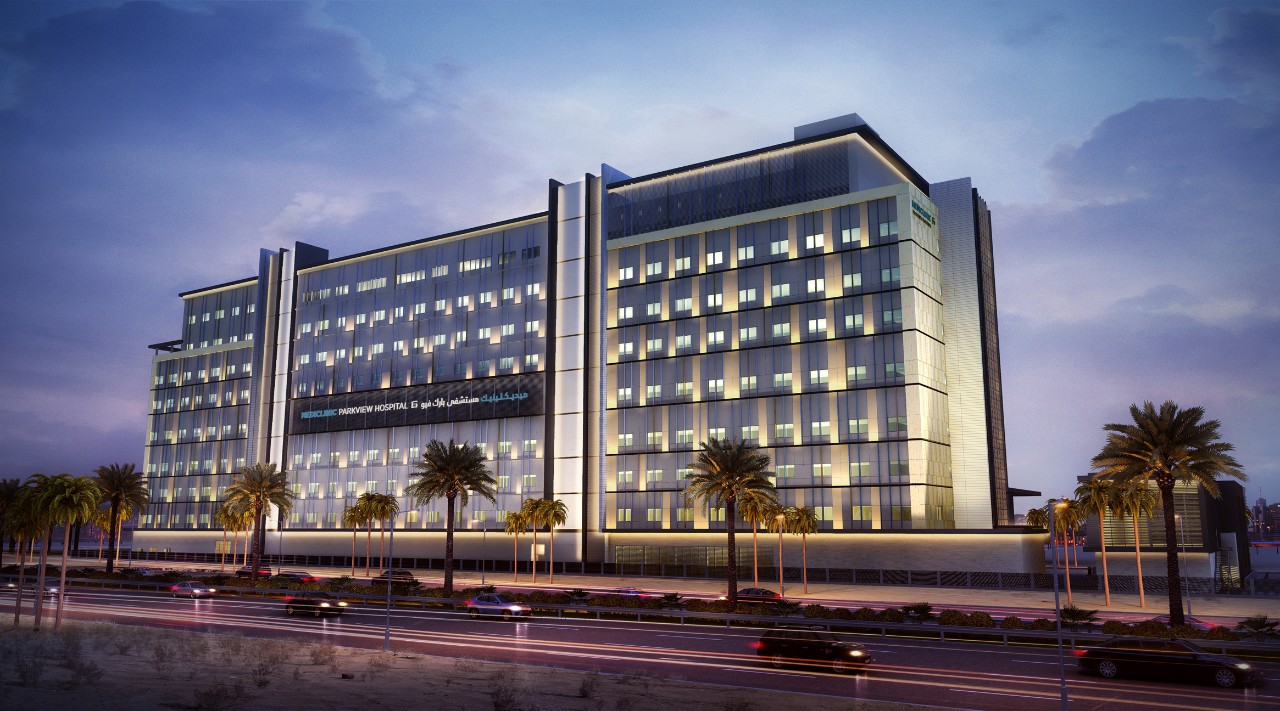Mediclinic Parkview Hospital: Breaking New Grounds
By Inga Louisa Stevens, Contributing Writer
For those who live and work in ‘New Dubai’ on the Southern side of the United Arab Emirates, some may have caught a glimpse of the hive of construction activity going on along the Umm Suqeim road near Arabian Ranches. The new AED850 million 150+ bed general hospital - Mediclinic Parkview - which broke ground in February 2016, is the latest greenfield hospital project for Mediclinic Middle East.
Mediclinic Middle East, the company behind the popular Mediclinic City Hospital in Dubai Healthcare City and Mediclinic Welcare Hospital in Al Garhoud, is part of Mediclinic International, a private hospital group with three operating platforms in Southern Africa (South Africa and Namibia), Switzerland and the UAE, and a 29.9% shareholding in Spire Healthcare, a UK-based healthcare group with 38 hospitals. Mediclinic Middle East operates five hospitals and 38 clinics with more than 600 inpatient beds in the UAE.
The 500,000 square feet Mediclinic Parkview Hospital, which is expected to open to the public in early 2019 and employ more than 800 staff, will offer in-and outpatient services across a full range of medical disciplines as well as an A&E, ICU, NICU, rehabilitation and physiotherapy facilities, a VIP wing, a coffee shop area, a retail pharmacy and prayer rooms. Having recently signed with InterSystems to provide electronic health records services, Mediclinic Parkview will also be the first facility in the group to incorporate the system which will eventually be rolled out across the entire group in the UAE.
Location, Location, Location
Since entering the UAE market in 2008, Mediclinic Middle East has constantly sought opportunities to expand its business in line with the rate of growth of the country’s healthcare sector, which has been fuelled by an increasing population, greater penetration of insurance and a prevalence of lifestyle diseases. In Dubai, in particular, new residential developments have increased the need for medical services outside established areas.
According to Mediclinic Middle East CEO David Hadley, the decision to build Mediclinic Parkview in ‘New Dubai’ was based on careful consideration of the area including patient demographics and the services that the population will need. “We saw that the southern side of Dubai was a growing area and we identified that there are a lack of quality operators on this side of town,” he says.
Hadley has personally been involved in the conception, design and build of many Mediclinic hospitals in both Southern Africa and the UAE. He says that being able to tap into the Mediclinic International’s more developed markets such as the UK and Switzerland, is extremely advantageous when building new facilities in more developing countries such as the UAE. “This means that we can learn from the experiences in different countries and we can elevate our clinical expertise to an exceptional standard,” he adds.
The Secrets of the Design
Hadley, together with Mediclinic Middle East Chief Operating Officer Tarek Fathey and Alan Wilkinson, who is the Senior Director of Engineering Services at Mediclinic Middle East, worked with architects from Stantec International to optimise the design process for Mediclinic Parkview Hospital and draw from their combined years of experience working on similar greenfield hospital projects around the world, including the Mediclinic City Hospital which opened in 2008.
“We went through a very rigorous selection process for all of the architects for the project and Stantec, as an international firm with a lot of experience building hospitals in the region, had all the attributes we were looking for to take the helm of the design of our new hospital,” says Hadley.
According to Abhishek Gupta, who is the senior associate manager of architecture and interiors at Stantec International, “The design team at Stantec espoused Mediclinic’s brand drivers - practical, exacting, deliberate, orchestrated and human - and translated these ethos into an extremely efficient and high-quality design solution which addresses the constraints and opportunities of the Parkview site, is tailored to the specific needs of Mediclinic’s operating model and brand guidelines, and is detailed and finished to create a patient experience that would attract the discerning clientele of South Dubai and beyond.”
Gupta explains that while the design of the building may not seem extraordinary at the first glance, on a closer look one would notice a highly ‘optimised’ facility, designed to deliver excellence in healthcare. “‘Optimisation’ was the key philosophy that was high on the stakeholders’ agenda and the design process went through several rounds of optimisation right from the facility programming stage to detailed documentation of design to enhance the value of the project, removing any inefficiencies or unnecessary redundancies along the way,” he says.
The Mediclinic Parkview Hospital site itself - a narrow linear site with a relatively small footprint and a north-south orientation, posed the main challenges for the architects during the design process. The hospital needed segregated access points for the various traffic types and multiple departments vied for the prime ground floor space. The design team responded by reducing the functions at the ground level to those absolutely necessary – moving visitors to other floors quickly and efficiently upon entering the main lobby. The long façade was punctuated with vertical elements to break the horizontality and the less-than-ideal building orientation was tackled with the use of external and internal shading devices to cut the glare and solar heat gain. The external shading fins were then given a touch of colour to convert them into an aesthetic feature and add interest to the overall composition.
“Sustainability has also been a top priority throughout the design process – whether it is the efficiency of layouts for sustainable operations or active and passive building and systems design for environmental sustainability. The design incorporates several sustainability best practices e.g. high-performance façade system, solar water heating, all LED lighting, water-efficient plumbing fixtures, energy recovery, condensate recovery etc.,” explains Gupta.
Lessons Learned
For Hadley, Fathey and Wilkinson, having previously been involved in many hospital and clinic construction projects, gives them the foresight to learn from where the problem areas lie in other Mediclinic facilities around the world. For example, they took the lessons learned from Mediclinic City Hospital and were able to apply those learnings to the design of Mediclinic Parkview Hospital.
As Hadley explains, “At Mediclinic City Hospital, we know that when you arrive on the wards, there is a reception area at the front of the ward that is hardly ever manned by hospital staff. The reason for this is simple; because all the staff want to sit together. So when it came to the design of the Mediclinic Parkview Hospital, we took this into consideration and ensured that all the lifts come out at the nursing station so you don’t have a separate reception area.”
“Not only are the patients and visitors happy, but so is the staff,” he adds.
At Mediclinic City Hospital, each room is designed as a single bedroom but Hadley and the team quickly identified that patients were not able to look directly outside from their beds because the bathrooms were taking up window space. “What we did in the design of the new hospital was we brought the bathrooms to the corridor side and kept the bedroom towards the window side,” Hadley says. “Most hotels are designed this way.”
A central principle across all Mediclinic facilities is that the staff are well looked after. “We were determined to take this as an opportunity to create better amenities and facilities for our staff at the new hospital,” Hadley explains. “For example, the staff canteen area is on the roof of the facility which gives them a nice view and a larger recreation area where they can enjoy some fresh air during their shift.”
The design of the beds at the ICUs in Mediclinic Parkview Hospital is also quite unique. “An ICU is a one-on-one situation with a permanent nurse looking after you and it’s usually quite tricky for the nurses to perform their activities without disturbing the patient,” he says. The solution, according to Hadley, was to develop the ICUs so that there is an outside viewing station with sliding doors so that the nurses can stand between two patients to keep an eye on them without causing a disturbance.
Hadley explains that a pneumatic tube system will be installed throughout the entire hospital. “Most new hospitals do not consider this because it is very expensive but we prefer to look at the long-term benefits. You do gain efficiencies in the long run but you need to be able incorporate this early on in the planning phase of the facility.”
A Bright Future
Aside from the undertaking of the design and construction of the Mediclinic Parkview Hospital, it has been a busy few years for Mediclinic Middle East on many fronts. In February 2016, Mediclinic International combined with Al Noor Hospitals Group, with operations mainly in Abu Dhabi, to create an enlarged Mediclinic group now boasting 73 hospitals and 43 clinics.
And with the ongoing integration of their facilities with the Al Noor Group, with many existing facilities being expanded and upgraded throughout the company’s UAE portfolio, as well as the rebranding of all of the hospitals as Mediclinic, the future for this forward-thinking international hospital group looks very exciting indeed.


